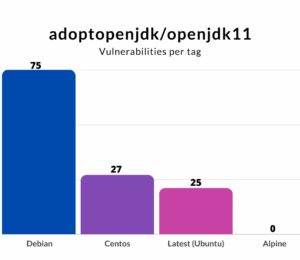Playing with WASM on Docker
- January 03, 2024
- 2737 Unique Views
- 4 min read
The idea of bytecode that can run anywhere dates back to the JVM inception (as far as I know).
WebAssembly is the new implementation of an old idea. While WebAssembly is meant to run in the browser, Docker recently announced its capability to run WASM code without needing containers.
In this post, I want to explore how it can work.
Prerequisite
Running WebAssembly is a beta feature and requires using containerd. To enable containerd, go to the Docker Desktop dashboard, then Settings > Features in development > Beta features > Use containerd for storing and pulling image.
Be warned that enabling containerd previously broke one of my Kubernetes demos. Play with WASM to your heart's content, but remember to roll back the configuration immediately afterward, or there's a chance downloaded containers won't run anymore.
I want to compare regular images with WebAssembly; hence, I require a project that can compile to both native code and WASM. For this reason, I chose to use the Rust language. I'll have a single simple project with two Dockerfiles: one that compiles to native, the other that compiles to WASM.
Building locally
Here's the Rust expected Hello World:
fn main() {
println!("Hello, world!");
}
We can install the Webassembly target and build locally for comparison purposes:
rustup target add wasm32-wasi cargo build --target wasm32-wasi --release
The file is relatively small:
-rwxr-xr-x 1 nico staff 2.0M Jun 4 15:44 wasm-native.wasmBuilding the basic Docker images
The Dockerfile that builds the Webassembly image is the following:
FROM rust:1.70-slim-bullseye as build #1 COPY Cargo.toml . COPY Cargo.lock . COPY src src RUN rustup target add wasm32-wasi #2 RUN cargo build --target wasm32-wasi --release #3 FROM scratch #4 COPY --from=build /target/wasm32-wasi/release/wasm-native.wasm wasm.wasm #5 ENTRYPOINT [ "/wasm.wasm" ]
- Start from the last Rust Docker image
- Add the WASM target
- Build, targeting Webassembly
- Use a multi-stage build. Start from scratch
- Copy the Webassembly file generated in the previous stage
The reference material uses the --platform wasi/wasm32 argument when building the Docker image. It doesn't work on my machine. It may be because I'm on an M1 Mac, or the documentation needs to be updated. In any case, I build "normally":
docker build -f Dockerfile-wasm -t docker-wasm:1.0 .
We can now run it, specifying a supported WASM runtime:
docker run --runtime=io.containerd.wasmedge.v1 docker-wasm:1.0
To compare, we can create a native image with the same code:
FROM rust:1.70-slim-bullseye as build COPY Cargo.toml . COPY Cargo.lock . COPY src src RUN RUSTFLAGS='-C target-feature=+crt-static' cargo build --release #1 FROM scratch #2 COPY --from=build /target/release/wasm-native native
- Make the binary self-sufficient
- Can start from scratch
We can now compare the images size:
REPOSITORY TAG IMAGE ID CREATED SIZE docker-native 1.0 0c227194910a 7 weeks ago 7.09MB docker-wasm 1.0 f9a88747f798 4 weeks ago 2.61MB
The Webassembly image is about one-third of the native binary package.
We cheat a bit because we add the WASM runtime... at runtime.
Building more complex images
Let's see how we can add parameters to the binary and update the code accordingly:
use std::env;
fn main() {
let args: Vec<String> = env::args().collect();
if args.len() > 1 {
println!("Hello, world!");
} else {
println!("Hello, {}!", args[1]);
}
}
Let's rebuild the images and compare again:
REPOSITORY TAG IMAGE ID CREATED SIZE docker-native 1.0 0c227194910a 7 weeks ago 7.09MB docker-native 1.1 3ae029030e83 39 minutes ago 7.1MB docker-wasm 1.0 f9a88747f798 4 weeks ago 2.61MB docker-wasm 1.1 41e38b68f4e4 39 minutes ago 2.63MB
Executing HTTP calls?
With this, it's easy to get carried away and start thinking big: what if we could execute HTTP calls?
I'll use the reqwest crate since I'm familiar with it. reqwest relies on Tokio.
[dependencies]
reqwest = { version = "0.11", features = ["json"] }
tokio = { version = "1.28", features = ["full"] }
serde = { version = "1.0", features = ["derive"] }
We can now update the code to make a request to and print the result:
#[tokio::main]
async fn main() {
match get("http://httpbin.org/get").await {
Ok(response) => {
let result = response.json::<GetBody>().await;
match result {
Ok(json) => {
println!("{:#?}", json);
}
Err(err) => {
println!("{:#?}", err)
}
}
}
Err (err) => {
println!("{:#?}", err)
}
}
}
#[derive(Debug, Serialize, Deserialize)]
struct GetBody {
args: HashMap<String, String>,
headers: HashMap<String, String>,
origin: String,
url: String,
}
Compiling this code reveals WASM limitations, though:
#0 12.40 error: Only features sync,macros,io-util,rt,time are supported on wasm.
#0 12.40 --> /usr/local/cargo/registry/src/index.crates.io-6f17d22bba15001f/tokio-1.28.2/src/lib.rs:488:1
#0 12.40 |
#0 12.40 488 | compile_error!("Only features sync,macros,io-util,rt,time are supported on wasm.");
#0 12.40 | ^^^^^^^^^^^^^^^^^^^^^^^^^^^^^^^^^^^^^^^^^^^^^^^^^^^^^^^^^^^^^^^^^^^^^^^^^^^^^^^^^^
WASM is not multi-threaded, while Tokio is by default. We can, however, configure Tokio to work in a single-thread environment. Let's start by using the features that we need: macros for the main function and rt for the tokio runtime.
tokio = { version = "1.28", features = ["rt", "macros"] }
Now, we can limit Tokio to the unique thread:
#[tokio::main(flavor = "current_thread")]
async fn main() {}
Compiling now works. However, I encounter issues when running:
[2023-06-05 12:22:11.986] [error] instantiation failed: unknown import, Code: 0x62
[2023-06-05 12:22:11.986] [error] When linking module: "__wbindgen_placeholder__" , function name: "__wbindgen_object_drop_ref"
[2023-06-05 12:22:11.986] [error] At AST node: import description
[2023-06-05 12:22:11.986] [error] At AST node: import section
[2023-06-05 12:22:11.986] [error] At AST node: module
docker: Error response from daemon: Others("unknown import"): unknown.
The reqwest crate doesn't work with the WASI environment. Until it does, there's a fork aptly named reqwest_wasi. The tokio_wasi is the WASI-compatible crate for tokio. Note that the latter's version needs to catch up. Let's replace the crates:
[dependencies]
reqwest_wasi = { version = "0.11", features = ["json"] }
tokio_wasi = { version = "1.25", features = ["rt", "macros"] }
With the new crates, compilation works, as well as execution. On the other side, the native image works flawlessly, with slight changes for the Dockerfile:
#docker build -f Dockerfile-native -t docker-native:1.2 . FROM rust:1.70-slim-bullseye as build COPY Cargo.toml . COPY Cargo.lock . COPY src src RUN apt-get update && apt-get install -y pkg-config libssl-dev #1 RUN cargo build --release FROM debian:bullseye-slim #2 COPY --from=build /target/release/wasm-native native ENTRYPOINT [ "/native" ]
- Install required libraries for SSL
- Change to a more complete base image to avoid installing additional libraries
Here's the final comparison:
REPOSITORY TAG IMAGE ID CREATED SIZE docker-native 1.0 0c227194910a 7 weeks ago 7.09MB docker-native 1.1 3ae029030e83 22 hours ago 7.1MB docker-native 1.2 4ff64cf9de46 7 hours ago 123MB docker-wasm 1.0 1cc78a392477 23 hours ago 2.61MB docker-wasm 1.1 41e38b68f4e4 22 hours ago 2.63MB docker-wasm 1.2 6026f5bd789c 18 seconds ago 5.34MB
I didn't fiddle with the optimization of the native image. However, it would be hard to beat the WASM image, as it stands below 6MB!
There's no chance to implement an Axum server, though.
Conclusion
I implemented a couple of WASM Docker images in this post, from the most straightforward Hello World to an HTTP client.
While the ecosystem has room for improvement, it's already possible to benefit from Docker's WASM support. The small size of WASM images is a huge pro.
The complete source code for this post can be found on GitHub.
To go further:
Originally published at A Java Geek on June 11th, 2023
Don’t Forget to Share This Post!












Comments (0)
No comments yet. Be the first.